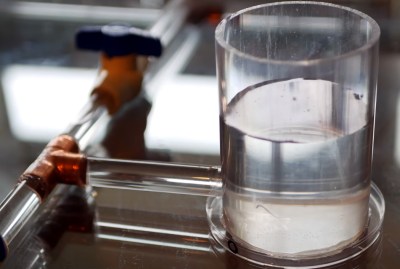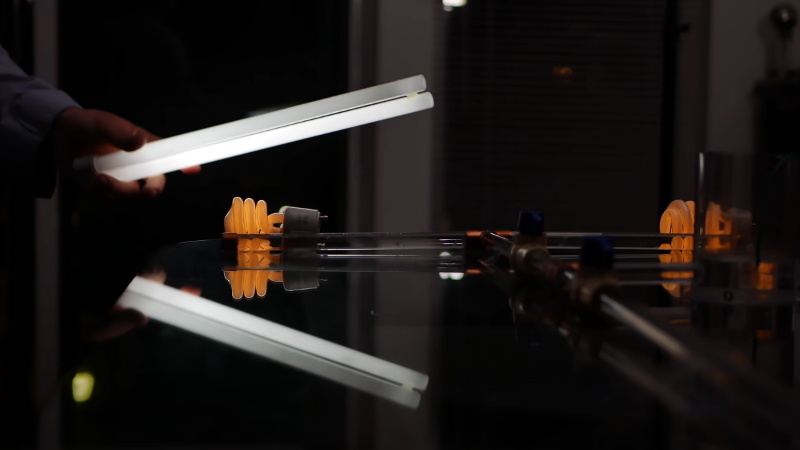The idea of transferring energy with water isn’t exactly new. In fact, it’s downright ancient. Running water has been tapped to power our contrivances since folks were getting excited about that new library they were opening up over in Alexandria. But what if there was a way to deliver power with water that wasn’t kinetic, and instead relied on the electrical properties of the planet’s favorite libation?
That’s exactly what [Jay Bowles] set out to explore with his latest experiment. Since water (we know, not pure water) conducts electricity, it stands to reason that it could be used as a stand-in for traditional copper wiring. Why would you want to do such a thing? Because unlike wires, water can easily morph into whatever shape may be required, and can be moved around and controlled with nothing more complex than ball valves.
 To test this concept, [Jay] put together a water distribution system out of simple acrylic tubing. A reservoir was attached to one of his high voltage generators, and copper caps were placed at the end of the tubes to serve as direct attachment points for devices.
To test this concept, [Jay] put together a water distribution system out of simple acrylic tubing. A reservoir was attached to one of his high voltage generators, and copper caps were placed at the end of the tubes to serve as direct attachment points for devices.
But thanks to capacitive coupling, the fluorescent lights he uses don’t actually need to be physically connected to light up. As demonstrated in the video after the break, the lights surrounding the system can be independently controlled just by turning their respective valves on and off; all without any physical contact being made.
Of course, compared to traditional wiring there are plenty of downsides to this idea. Copper wires don’t tend to freeze in the winter and spring a leak, nor do they build up bubbles of explosive hydrogen gas. So it’s safe to say the wiring in your house probably won’t ever be replaced with a tube of charged water. But [Jay] does have some interesting ideas of how this technique could be used in non-traditional ways. For example, he describes how outdoor lighting could be powered by the energy radiating from a small stream.
Even if the practical applications of this technique are somewhat limited, there’s no question that it’s a fascinating idea. Believing that he’s the first person to ever demonstrate power transmission under these specific circumstances, he’s decided to call the concept “Bowles Transmission”. We’d love to see somebody use this principle in one of their projects, and we’re willing to bet so would [Jay].
As with his recent ozone sterilization experiments, we imagine this idea is going to be met with some debate. But that’s sort of the point. [Jay] doesn’t claim to have all the answers, and hopes these videos get people thinking and talking. As they say, nothing great was ever achieved without enthusiasm.
















There may be some argument about being first to demonstrate transfer of power via water… but it depends on how specific you get. This paper talks about power and data transmission through open water (fresh and salt).
https://ieeexplore.ieee.org/stamp/stamp.jsp?arnumber=6758505
Single wire earth return power systems have been in use for about 100 years: https://en.wikipedia.org/wiki/Single-wire_earth_return
Fortunately it’s illegal in EU since early 2000s.
The NorNed cable to Norway still uses earth return. I think it was even build after that date.
It also has a 35,000 metric tons lead outer shield, dumped right into the ocean to compensate for all your lead-free solder.
The 35000 tons is total cable weight and theres a protective PE-jacket over the lead sheath.
Seems a bit risky
Why on earth would you do this? Those pipes provide no advantage over regular wires. And if wireless transfer of power from distribution system to bulb is what you’re after then, at such high voltages as this, it would work just as well * to use a metal rod instead of the water tubes.
*actually a bit better as most metals have lower resistance losses than the water will
And he talks of using ball valves to turn it on and off. Firstly I wouldn’t trust such a valve to be a reliable high resistance, most of the more high quality less likely to leak valves are made of metal anyway. Secondly, switches are cheap and easy to get, cheaper than even plastic valves. You might say at this point that such switches are usually rated for 1 volt up to maybe 400V, but for most applications high voltages get pretty wasteful. Yes, you need fairly high voltages to induce sufficient electric fields in the space around them to make fluorescent tuebs glow, but there are better more effective ways t transfer power which don’t need such wasteful voltages.
Shhh, let people enjoy things.
Eh there’s situations in which this saying makes sense, like people’s music tastes or whatever. This is pretty senseless and quite obviously exists to invite bafflement, so I get it.
Anybody wanna volunteer to touch one of those high-voltage ball-valves which isn’t rated in any way whatsoever to isolate electric current from your heart? Considering that any project using mains voltage gets lots of worry and criticism of irresponsibility and people crying “use a wall wart!” I’m surprised to see this.
well for a start, no bastard will nick them for the copper.
+1
This article really is a bit much. There isn’t really anything novel going on on here with the water, it’s just a static conductor which can be broken by the valve.
The
“Control of the elements” from the youtube channels’ about page also shows the sort of bizarre perspective this guy has
Have you seen the videos of him on Discovery Channel and that Spanish show, controlling fire water and wind? He has videos about it. Not really a bizarre perspective if the dude can actually do it, and in front of live TV. I’ve never seen someone do that before, period. Hats off to the weirdo.
Underwater radio has been a topic of research for the military for more than 50 years
Deionized water with extremely high resistance can generate high voltage if you pump it through an acrylic pipe with metal electrodes at each end. VERY HIGH VOLTAGE. Be careful!
Can you elaborate on that? Link to Wikipedia article? That sounds very cool and I think I should try that
Imagine a Van de Graaff generator with a liquid belt.
I think they’re trying to describe the phenomenon [Ben] of applied science demonstrated in this video a few years ago
https://www.youtube.com/watch?v=_vTq8oGpqwM
No, none of the above. It’s really just a triboelectric device. Water is a conductor because of ions. If you deionize the water (I think they actually used two deionizers in series) then it’s an insulator. If you rub two insulators against each other they generate charge based on the triboelectric series. Water usually isn’t usually in the series because it’s usually a conductor. So rubbing deionized water against acrylic plastic (Perspex in the UK) will generate charges. The conductors at the ends collect the charges. I have a paper on this, but it’s buried in my non-organized files. I think the original test of this was done in the UK (they actually said Perspex). And it was years ago (1950s-1960s). They used a low power pump, lab type, nothing special.
Water is a terrible conductor. It is dirty water that is somewhat more conductive, but still not great. That is why you don’t want a toaster in the bath with you. The electrons would rather pass through you to the drain than via the water. If water was highly conductive, it would act to ground the power and save you.
And I always assumed it was because the toast goes soggy. (unless you butter both sides before putting in the toaster)
“For example, he describes how outdoor lighting could be powered by the energy radiating from a small stream”
Wait what? Energy “radiating” from a stream? A stream will be a defacto ground, no electricity there.
Stream does not mean connected to ground. It just means a fountain that circulates water around a cafe. I saw what he was saying. Easy to physically and electrically isolate a stream from ground.
not if you completely isolate it first – which makes the idea even more nonsensical.
“the first person to ever demonstrate power transmission under these specific circumstances”
I know it’s a bit tongue in cheek, but this really is about as novel as using sodium metal to complete a normal circuit.
Sure, nobody does it because it’s not worth the hastle, but it’s not fundamentally different to using copper.
What about the Hydrogen that will be produced and showing up in the worst places
Water as a conductor though? Meh. It’s good as a self-renewing resistor if you have to dump huge power into a tub of it. But electrochemical effects on electrodes tends to make it of little use unless you’re willing to throw away a lot of those.
On the other hand..
Water insulation (but deionised) is very common in the VERY high voltage DC machines. It’s a great insulator because it self heals. The textbooks you don’t know yet that you need to read are call the field ‘Pulsed Power’. They talk of things like MA (that’s Mega Amps) and MV, and disclose the technical details of how these ridiculous electrical power levels are accomplished.
Here’s an excerpt from “Pulsed Power Systems” Bluhm, Hansjoachim, 2006 https://www.springer.com/gp/book/9783540261377
“We shall speak of pulsed power if the electrical power of the pulses is around one gigawatt (10^9 W) and if their energy content is of the order of one kilojoule or greater. The highest energy and power that have been achieved in a single pulse are at present of the order of 100 MJ and a few hundred terawatts respectively. The corresponding voltage and current amplitudes are between 10kV and 50 MV and between 1 kA and 10 MA, respectively.”
There’s also “Pulsed Power” by Gennady A. Mesyats, which is an even better read, going in minute detail about exactly what is happening when a spark discharge occurs. It involves part of the conductor detonating in a mess of loose electrons and metal ions, due to exceeding the maximum thermal dissipation limit of the metal.
It turns out, once someone realised that you have to de-skew a current probe to get it into time-alignment with a voltage signal (else they’re out by ~50 ns, enough to make measuring power by multiplying the traces fail), then you can reduce the data from exploding wire measurements down a single, element characteristic energy / volume limit.
Whenever thermal energy reaches this limit, the metal will spontaneously detonate. For gold it was a little under 75 J/cubic millimetre. (they were talking about 26mJ @ 420 .. 900 kW). https://www.osti.gov/pages/servlets/purl/1427227